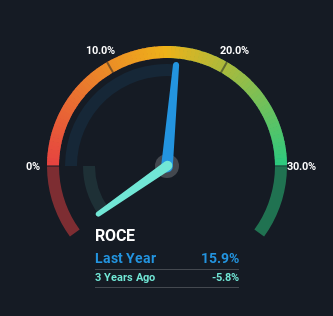- Australia
- /
- Entertainment
- /
- ASX:PLY
Returns On Capital At PlaySide Studios (ASX:PLY) Paint A Concerning Picture

What are the early trends we should look for to identify a stock that could multiply in value over the long term? In a perfect world, we'd like to see a company investing more capital into its business and ideally the returns earned from that capital are also increasing. This shows us that it's a compounding machine, able to continually reinvest its earnings back into the business and generate higher returns. However, after briefly looking over the numbers, we don't think PlaySide Studios (ASX:PLY) has the makings of a multi-bagger going forward, but let's have a look at why that may be.
Understanding Return On Capital Employed (ROCE)
For those who don't know, ROCE is a measure of a company's yearly pre-tax profit (its return), relative to the capital employed in the business. To calculate this metric for PlaySide Studios, this is the formula:
Return on Capital Employed = Earnings Before Interest and Tax (EBIT) ÷ (Total Assets - Current Liabilities)
0.16 = AU$8.0m ÷ (AU$62m - AU$11m) (Based on the trailing twelve months to December 2023).
Therefore, PlaySide Studios has an ROCE of 16%. On its own, that's a standard return, however it's much better than the 8.3% generated by the Entertainment industry.
See our latest analysis for PlaySide Studios

Above you can see how the current ROCE for PlaySide Studios compares to its prior returns on capital, but there's only so much you can tell from the past. If you'd like, you can check out the forecasts from the analysts covering PlaySide Studios for free.
What The Trend Of ROCE Can Tell Us
When we looked at the ROCE trend at PlaySide Studios, we didn't gain much confidence. To be more specific, ROCE has fallen from 58% over the last five years. Although, given both revenue and the amount of assets employed in the business have increased, it could suggest the company is investing in growth, and the extra capital has led to a short-term reduction in ROCE. If these investments prove successful, this can bode very well for long term stock performance.
On a side note, PlaySide Studios has done well to pay down its current liabilities to 18% of total assets. That could partly explain why the ROCE has dropped. Effectively this means their suppliers or short-term creditors are funding less of the business, which reduces some elements of risk. Since the business is basically funding more of its operations with it's own money, you could argue this has made the business less efficient at generating ROCE.
Our Take On PlaySide Studios' ROCE
Even though returns on capital have fallen in the short term, we find it promising that revenue and capital employed have both increased for PlaySide Studios. And the stock has done incredibly well with a 168% return over the last three years, so long term investors are no doubt ecstatic with that result. So while investors seem to be recognizing these promising trends, we would look further into this stock to make sure the other metrics justify the positive view.
One more thing to note, we've identified 1 warning sign with PlaySide Studios and understanding this should be part of your investment process.
For those who like to invest in solid companies, check out this free list of companies with solid balance sheets and high returns on equity.
New: Manage All Your Stock Portfolios in One Place
We've created the ultimate portfolio companion for stock investors, and it's free.
• Connect an unlimited number of Portfolios and see your total in one currency
• Be alerted to new Warning Signs or Risks via email or mobile
• Track the Fair Value of your stocks
Have feedback on this article? Concerned about the content? Get in touch with us directly. Alternatively, email editorial-team (at) simplywallst.com.
This article by Simply Wall St is general in nature. We provide commentary based on historical data and analyst forecasts only using an unbiased methodology and our articles are not intended to be financial advice. It does not constitute a recommendation to buy or sell any stock, and does not take account of your objectives, or your financial situation. We aim to bring you long-term focused analysis driven by fundamental data. Note that our analysis may not factor in the latest price-sensitive company announcements or qualitative material. Simply Wall St has no position in any stocks mentioned.
About ASX:PLY
PlaySide Studios
Develops and sells mobile, PC, and console video games in Australia.
Very undervalued with flawless balance sheet.
Market Insights
Community Narratives



